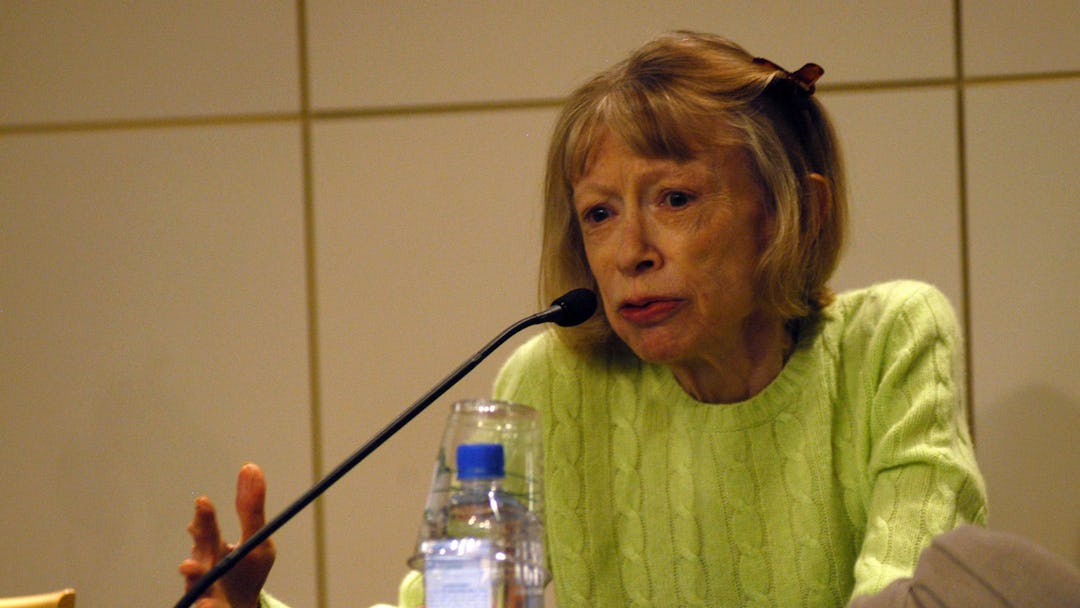The idea of Joan Didion-as-symbol has been floating around in the ether lately. It’s quick cultural shorthand to say that, particularly if you are a middle-class white girl with writerly aspirations, you have good taste in writing, which in the case of “Joan Didion” may also translate to, “I have good taste/I could work for Vogue/I could see the dim future of a rotten decade and take to my bed for days, an aura around my head.”
I have had cocktail-party conversations about this latent Didion fetishism (or, as Leah Finnegan put it on Twitter yesterday, “Joananism,” which is perfect), but it took The Hairpin editor Haley Mlotek to write a smart piece dissecting this phenomenon on The Awl. As she puts it, citing Joan Didion as your idol says that:
…we’re cool, that we’re educated, that if we are not young and white and slender and well-dressed and disaffected and sad and committed to the art of writing as an arduous and soul-sucking process that must be endured yet Instagrammed simultaneously, then we will be, at least, as close as possible to those identifiers even if it kills us.
Mlotek’s correct, and she’s especially correct as it pertains to the high-end fashion designers Celine and Saint Laurent’s decisions to use Didion and legendary musician Joni Mitchell, respectively, as the faces of their (very expensive) brands. It is a case where brands are flaunting their exclusivity by focusing on iconic senior women (an age where women often just disappear from the cultural spotlight), women who are part of the regrettably short list of female creative icons, women who have succeeded — arguably transcending their femininity — to become canonical, college course fodder in their boys-club genres of journalism and music.
The Internet has a tendency to make life into one big video-game version of Nick Hornby’s High Fidelity. As the film adaptation of the book puts it: “What really matters is what you like, not what you are like… Books, records, films — these things matter.” As connection reduces itself to something that’s found in 1s and 0s, the swipe of a finger on Tinder, your cultural preferences carry more weight, and we don’t get to grow beyond them, at least on first glance.
But the thing that’s odd and distancing about this tendency to fetishize great artists, to commodify their status for the sake of your own intelligence or a brand’s exclusivity and taste, is that it ends up obscuring just what makes the artist great — their work. You’d be forgiven for thinking that Didion has only written a packing list for Vogue, essays like “On Self Respect” and “Goodbye to All That,” and books like The White Album and Slouching Towards Bethlehem. A 50-year career, punctuated by some essential insights on politics, is reduced to a sliver of time in Didion’s life.
Even “On Keeping a Notebook” isn’t mentioned as much as it could be. The moving thing about Didion’s work is that it attempts — in what is often a futile effort — to make some sense, some narrative, out of stories that are often just random and cruel. To quote Didion in The Year of Magical Thinking: “We live entirely, especially if we are writers, by the imposition of a narrative line upon disparate images, by the ‘ideas’ with which we have learned to freeze the shifting phantasmagoria which is our actual experience.”
In all honestly, this should be a valedictory period for both Didion and Mitchell. For the former, the documentary We Tell Ourselves Stories in Order to Live, filming now, is a start. Didion’s increasing frailty in public appearances is also a reminder that our time with her is limited, and that we need to value it while we can. Rumor has it that Mitchell put the kibosh on a proposed film adaptation of Sheila Weller’s triple biography Girls Like Us, which had Taylor Swift slated to play young Mitchell. The work that they did that we have to read and listen to in order to get an idea of just what it was like to be a thoughtful young woman is done, finished, in the books, there for us to find and devour. You could read Didion’s work or listen to Mitchell tonight, in fact.
For women in particular, this tendency towards idolatry of certain female icons of culture is freighted with the weight of expectation. It’s arguable that the list of women who’ve achieved enviable success in their chosen creative field, who are referred to as living legends, who are even credited as talented by men, and who don’t disappear when family comes beckoning, is rather short.
There are scads of forgotten women who wrote something brilliant once, who had a smart career behind the scenes, who left the crucible of creativity once they needed to raise a family. There are also the women who are successful and written off as lightweight (at least for a while) — in that case, certain moments in Nora Ephron’s career come to mind. To have a 50-year-career as a woman artist or writer who is always taken seriously is rather miraculous, and women like Didion and Mitchell are part of an exclusive club.
The affection that we have for talents like Didion and Mitchell is well intentioned, but much of the time, it feels evanescent, and like it lacks heart. In a time when it’s easier than ever to say who you are through what you like, aren’t we losing something by failing to celebrate what these women have actually given us — their work?
